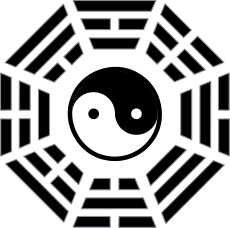Taegeuk
| Taegeuk | |
 The taegeuk found on the flag of South Korea. | |
| Korean name | |
|---|---|
| Hangul | 태극 |
| Hanja | 太極 |
| Revised Romanization | Taegeuk |
| McCune–Reischauer | T'aegŭk |
 |
| Part of a series on the |
| Culture of Korea |
|---|
| History |
|
Music and performing arts |
|
|
Monuments |
|
Taegeuk (Chinese: 太極; Korean: 태극, Korean pronunciation: [tʰɛgɯk̚], a loanword from Middle Chinese IPA: [tʰɑiHɡɨk̚] refers to the Absolute from which all things and values are derived. It is also the symbol that makes up the center of the flag of South Korea and the source for its name, taegeukgi (hanja: 태극기 , where gi means "flag"). The taegeuk is commonly associated with Daoist philosophical values as well as Korean shamanism.[1]
History
The origin of the taegeuk was Daoism, which spread to the Korean Peninsula and Japan as early as the Han dynasty.[2] The Korean word taegeuk (hanja: 太極 ) is a Sino-Xenic word that literally means "great pole" and figuratively means "the Absolute".
The taegeuk design dates back to the seventh century in Korea but recent excavations go back even further. There is a stone carved with the taegeuk design in the compound of Gameunsa, which was built in 628 during the reign of King Jinpyeong of Silla[3] and has a three-story pagoda that was designated National Treasure of South Korea 112. Traces of taegeuk designs have been found in the remains of the ancient cultures of Korea; in a Goguryeo tomb and in Silla remains.
Recently, a 1400-year-old artifact with the taegeuk pattern has been found in the Bogam-ri tombs of Baekje at Naju, South Jeolla Province, making it the oldest taegeuk found in Korea, predating by 682 years the taegeuk found at Gameunsa.[4]
The taegeuk has been used for centuries in the indigenous religions of Korea.[1] In Goryeo and Joseon, the design was later used to represent Daoism in Korea and to express the hope for harmony of yin and yang to enable the people to live happy lives with good government.[5] The blue and red swirling semicircles of the Taegeuk pattern have existed since ancient times.[6]
South Korean flag
The taegeuk symbol is most prominently displayed on South Korea's national flag, called the taegeukgi (along with four of the eight trigrams used in divination). Because of the taegeuk's association with the national flag, it is often used as a patriotic symbol, as are the colors red, blue, and black. The “geon” trigram (☰) represents the heaven, spring, east, and justice. The “gon” trigram (☷) symbolizes the earth, summer, west, and vitality, the “gam” trigram (☵) the moon, winter, north, and wisdom, and the “ri” trigram (☲) the sun, autumn, south, and fruition. The four trigrams supposedly move in an endless cycle from “geon” to “ri” to “gon” to “gam” and back to “geon” in their pursuit of perfection.[6] The white background symbolizes the homogeneity, integrity and peace-loving nature of the Korean people. Traditionally, Koreans often wore white clothing, earning the nickname “white-clothed people” and therefore the color white epitomizes the Korean people.[6]
Paralympic usage
The official paralympic symbol for the Paralympic Games used by the International Paralympic Committee had three taegeuk-like swirls in its logo prior to the end of the 2004 Summer Paralympics, when it was replaced with three Agitos. The usage of the swirls started at the 1988 Summer Paralympics in Seoul, using five Taegeuk designs arranged similarly to the Olympic Rings, with the same set of five colors.
Tricolored Taegeuk
A popular variant in Korea is the tricolored taegeuk (Hangul: 삼색의태극 ), which adds a yellow lobe or "pa" (hanja: 巴 Hangul: 파 ), representing humanity, to the red and blue pa which represent heaven & earth. The samsaeg-ui taegeuk is frequently seen as a design on the face of hand fans. A rendition of the tricolored taegeuk also appeared in the official logo of the 1988 Summer Olympics accompanied by the five Olympic rings.[7] A similar symbol is used by the Miss Asia Pacific World Beauty Pageant, which was hosted in South Korea from its inception in 2011 until 2014, and most recently hosted in Thailand in 2015.
Gallery
-

Taegeukgi, the flag of South Korea, with a blue and red taegeuk in the center.
-
.png)
Samsaeg-ui Taegeuk
-

Alternative Samsaeg-ui Taegeuk
-

Samsaeg-ui Taegeuk encircled by pal gwae.
-

Handheld Fan with a Samsaeg-ui Taegeuk Design
-

First Paralympic symbol (1988–1994) used five "pa" (巴).
-
.svg.png)
Second Paralympic symbol (1994–2004) used three "pa" (巴).
See also
- Culture of Korea
- Taegeuk (taekwondo)
- Gankyil
- Taiji (philosophy)
- Taijitu
- Tomoe
- Korean philosophy
- Triskelion
References
- 1 2 Korea's Sam-Taegeuk Symbol. san-shin.org, dedicated to the sacred mountains of Korea.
- ↑
- ↑ "구구덩 | The taegeuk pattern - Daum 카페". Cafe983.daum.net. Retrieved 2013-01-12.
- ↑ "Oldest Taegeuk Pattern Found in Naju". Koreatimes.co.kr. 2009-06-03. Retrieved 2013-01-12.
- ↑ An Illustrated Guide to Korean Culture - 233 traditional key words by The National Academy of the Korean Language
- 1 2 3 Archived November 5, 2010 at the Wayback Machine
- ↑ http://www.aldaver.com/Images/Os/lg1988sm.gif
